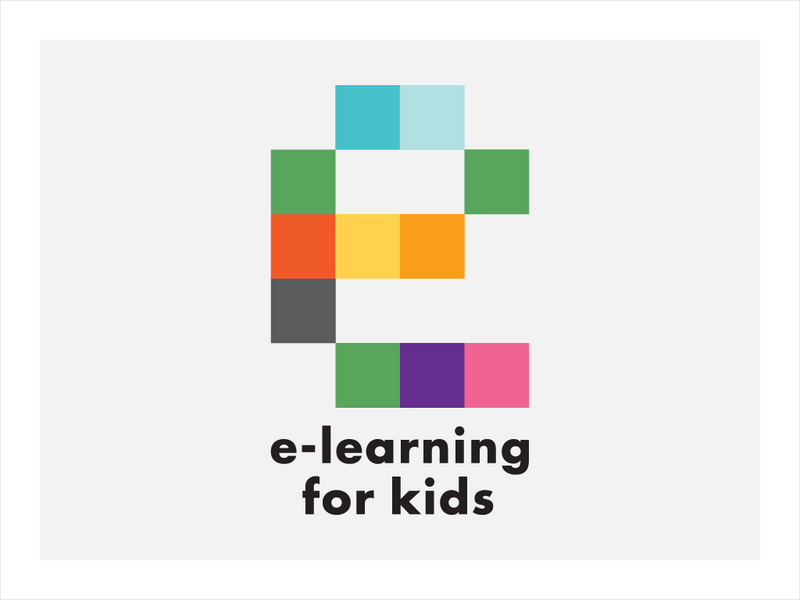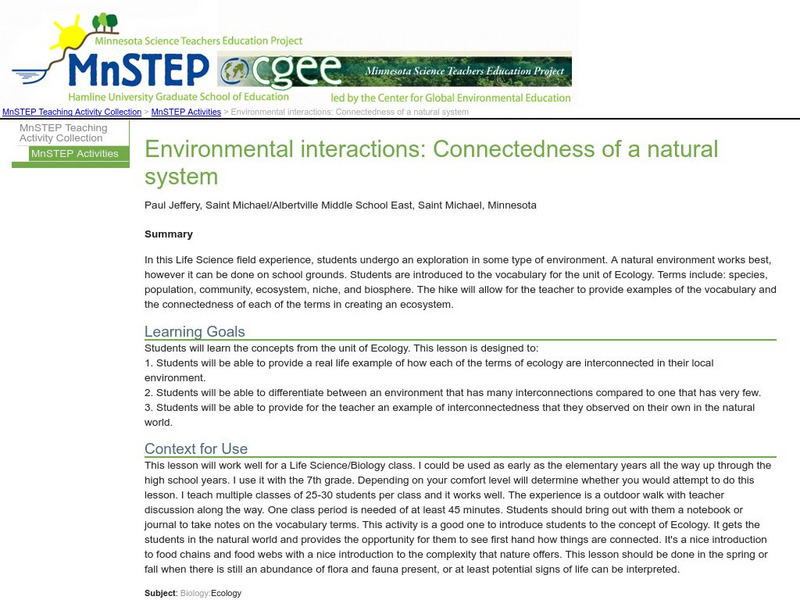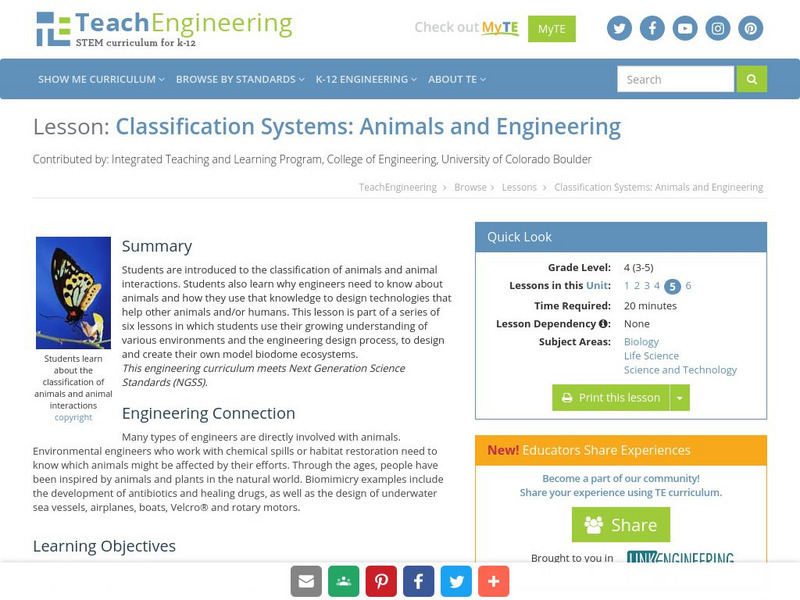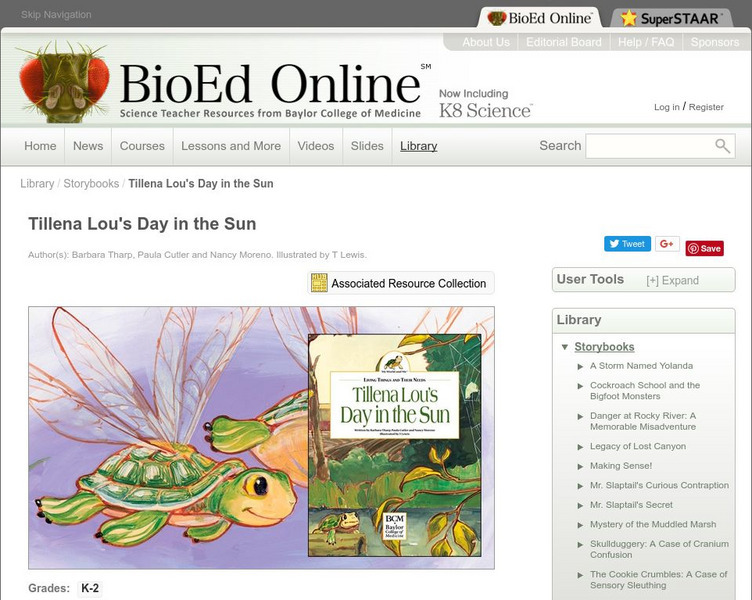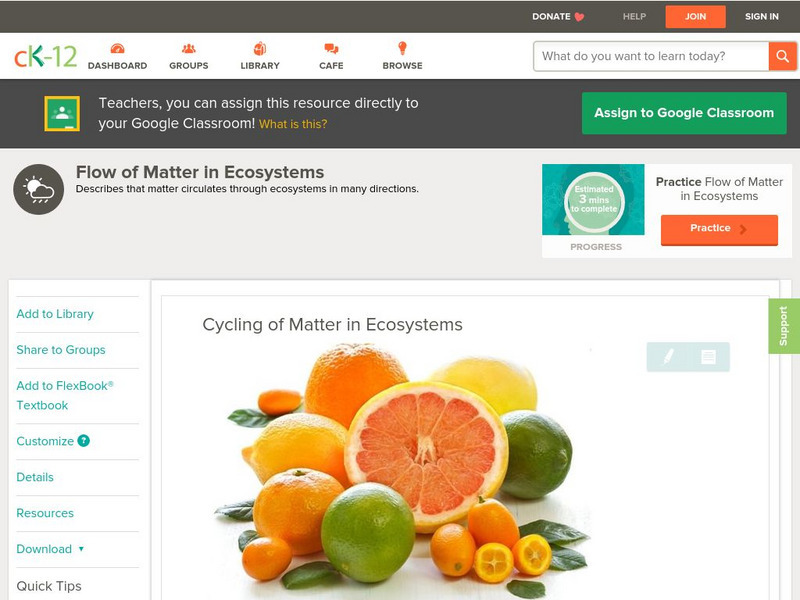Other
My Science Box: Ecosystem Organization
In this lesson, students will learn about the different levels in the hierarchy of ecology and explain the relationships: organism, population, community, ecosystem, biome, and biosphere. They will also discover why different regions...
Shmoop University
Shmoop: Ecosystem Energy Flow
Explains the processes by which energy flows through an ecosystem. Covers the meanings of key vocabulary, e.g., types of producers and consumers, trophic levels, food webs, and the energy pyramid.
E-learning for Kids
E Learning for Kids: Science: Bermuda Triangle: How Is Energy Transferred Between Organisms?
Bermuda is a mysterious place. Meet Scotty and his family and join them on their holiday to learn about energy transfer in ecosystems.
E-learning for Kids
E Learning for Kids: Science: South Africa: How Do Organisms Get Their Energy?
Join Ellen on her trip to the Kaap De Goede Hoop in South Africa, and learn more about plants, animals, and energy.
Environmental Education for Kids
Eek!: Alien Invaders
The aliens have landed in Wisconsin! You may see them and not even know they are aliens. These invaders are actually exotic plants and animals that have been introduced to our state from other countries or habitats on purpose or by...
Science Education Resource Center at Carleton College
Serc: Environmental Interactions: Connectedness of a Natural System
A field experience where students undergo an exploration in a natural environment. They are introduced to the concepts of species, population, community, ecosystem, niche, and biosphere.
Science Education Resource Center at Carleton College
Serc: The Microenvironment Project: Featuring Phenology
A field lab for biology that focuses students on the study of nature and its changes over time. Students are asked to observe and acquire knowledge of trees and the interdependence that a tree shares with other organisms.
Science Education Resource Center at Carleton College
Serc: Bio Media Associates: Learning Programs for Biology
This site provides photographs, animations, essays, teaching resources, multimedia, and other information about biological systems and organisms. It features a monthly contest and quiz in which students and teachers identify a mystery...
TED Talks
Ted: Ted Ed: Feedback Loops: How Nature Gets Its Rhythms
Anje-Margriet Neutel describes some common positive and negative feedback loops, examining how an ecosystem's many loops come together to make its 'trademark sound.' [5:11]
A-Z Animals
A Z Animals: Reference: Diet
This entry identifies the defining characteristics of the various diets of animals, including those that are herbivores, carnivores and omnivores.
TeachEngineering
Teach Engineering: Animals and Engineering
Young scholars are introduced to the classification of animals and animal interactions. Students also learn why engineers need to know about animals and how they use that knowledge to design technologies that help other animals and/or...
BioEd Online
Bio Ed Online: Tillena Lou's Day in the Sun
Tillena Lou and her siblings spend a lazy day imagining what it might be like if they were other types of animals. What would they need to survive? Synopsis: Tillena Lou explores her home and discovers interesting things about the...
ArtsNow
Arts Now Learning: Using Tableau and Role Drama to Examine the Ecosystem [Pdf]
In this lesson, 4th graders use tableaux to dramatize their roles in the food chain of an ecosystem. Next, they write in role arguing why they are important to the ecosystem. This is followed by a debate in the format of a Character...
CK-12 Foundation
Ck 12: Earth Science: Flow of Matter in Ecosystems
[Free Registration/Login may be required to access all resource tools.] How matter cycles within an ecosystem. SE 7.5B, 7.5C
CK-12 Foundation
Ck 12: Life Science: 10.23 Importance of Mammals
Learn about the importance of many mammals to humans.
Louisiana Department of Education
Louisiana Doe: Louisiana Believes: Social Studies: Grade 3: A Log's Life
Third graders learn about the interdependence of animals and trees in nature and the cycles of growth and decay. Students also learn about the importance of preserving balance in nature and what happens when we upset that balance. While...
US Geological Survey
Usgs: Earth Surface Dynamics (Research Activities)
This site from USGS provides several activities to help understand the interrelationships among earth surface processes, ecological systems, and human activities. Also included are links to new findings and programs concerning Earth...
PBS
Pbs Learning Media: Catch Me if You Can
Students are asked to explain the predator/prey relationship and how it helps to maintain the balance of the ecosystems.
Environmental Education for Kids
Eek!: Habitats
Take a look at some of the different habitats that are home to many plants and animals including black bears, owls and various species of birds.
Tom Richey
Slide Share: Ecosystems and You
Slideshow that looks at energy flow in an ecosystem. Explains what an ecosystem is, how energy flows through it, the producers and consumers of energy, and food chains. Links to a video about plastic debris in the ocean.
Sophia Learning
Sophia: Living Organisms and Their Environment: Lesson 2
This lesson will discuss the interactions of and interdependence among living things. It is 2 of 4 in the series titled "Living Organisms and Their Environment."
Sophia Learning
Sophia: Living Organisms and Their Environment: Lesson 3
This lesson will discuss the interactions of and interdependence among living things. It is 3 of 4 in the series titled "Living Organisms and Their Environment."
Sophia Learning
Sophia: Carrying Capacity: Lesson 2
This lesson will introduce the carrying capacity and show how it affects a population. It is 2 of 4 in the series titled "Carrying Capacity."
Sophia Learning
Sophia: Carrying Capacity: Lesson 3
This lesson will introduce the carrying capacity and show how it affects a population. It is 3 of 4 in the series titled "Carrying Capacity."




